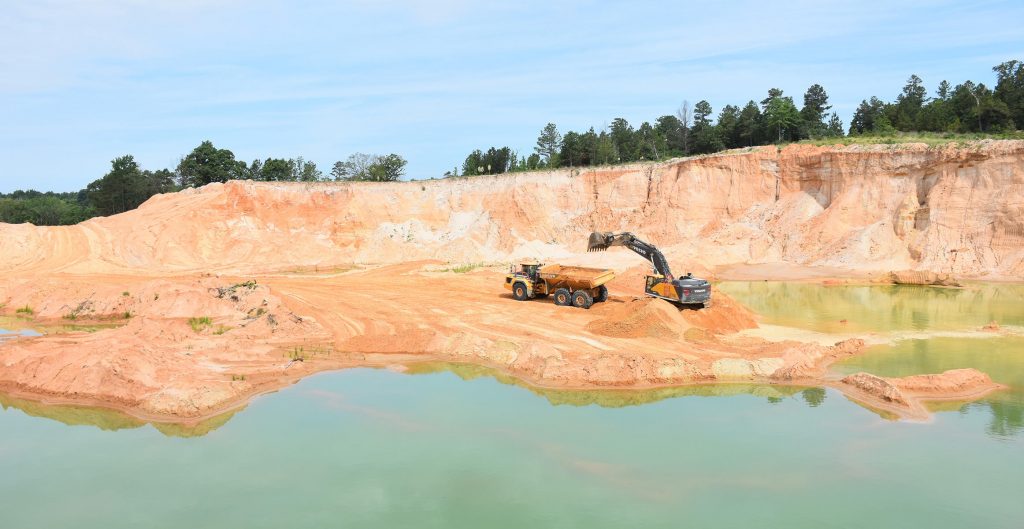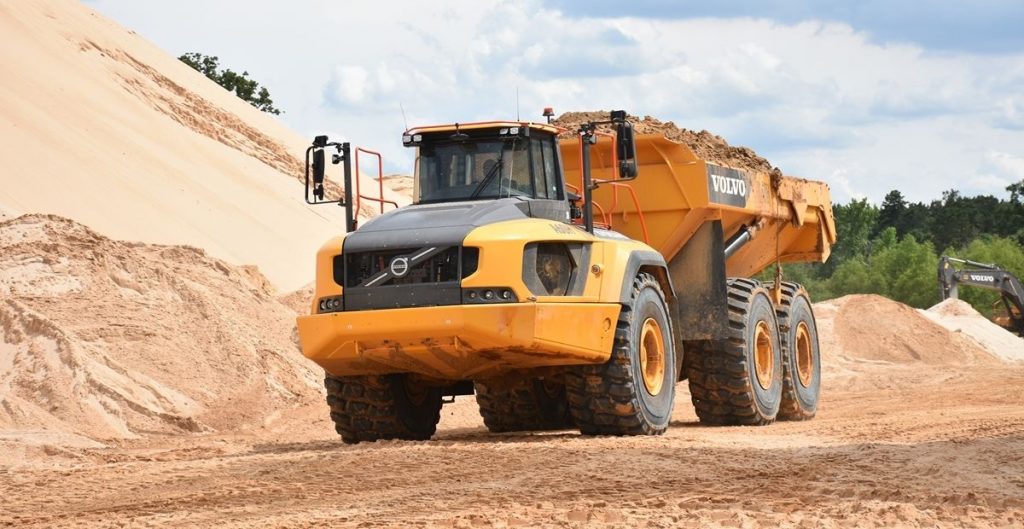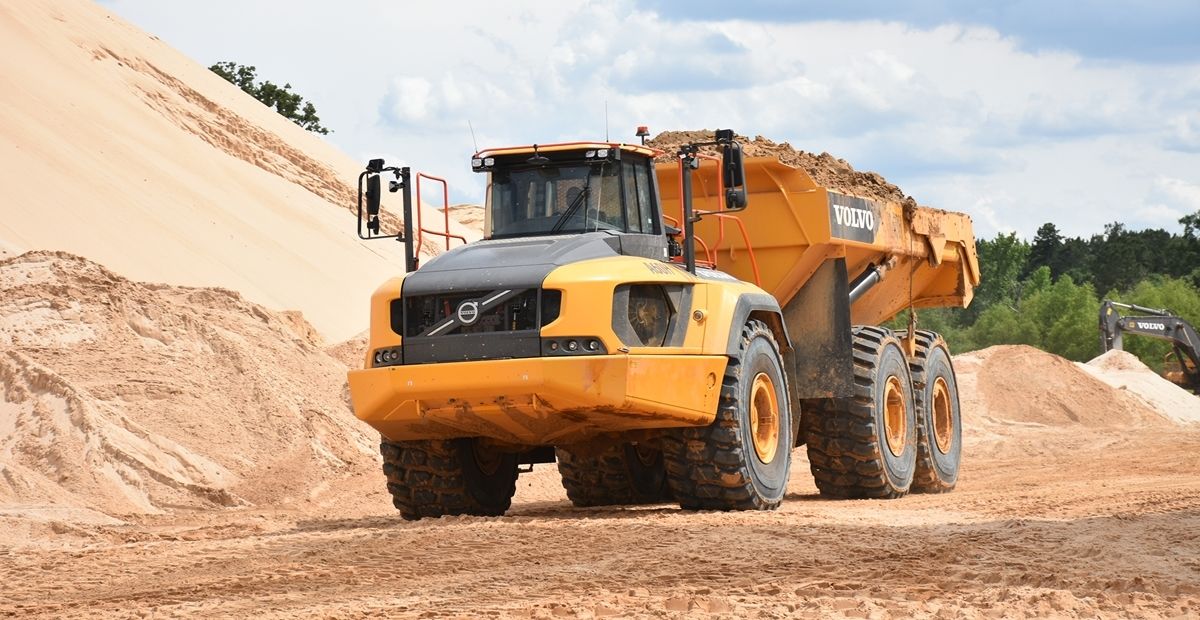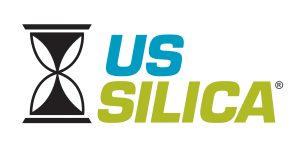In June 1998, an experiment to access gas trapped over a mile deep in the Barnett Shale north of Fort Worth, Texas, using sand, water and chemicals ignited a natural gas boom that rippled across the entire continent. Hydraulic fracturing — or fracking — injects high-pressure liquid and sand proppant into boreholes deep below the surface to open veins and extract petroleum.
Triple Output Production
Twenty years later and a few hundred miles south, a U.S. Silica quarry is churning out a highly-sought fine grade of frac sand that increases the amount of gas extracted. The finer granules penetrate minuscule fissures in the rock to allow access to hidden reserves. The demand is motivating U.S. Silica to triple output of production, with heavy reliance on an upgraded fleet of Volvo A60H haulers and EC750E excavators.
“This deposit is unique,” said Terry Lackey, plant manager for the U.S. Silica Tyler site. “The grain size is 100 mesh and 40-70 mesh, which is in high demand in the oil field right now, and our quarry is perfectly situated close to the east Texas oil field, so we can distribute the product quickly and at a low cost.”
Sand is trucked within a 100-mile radius and loaded onto rail cars and sent to the West Texas oil fields.
U.S. Silica purchased the 1,400-acre site in 2016 from New Birmingham Inc., and began investing in employees and mobile processing equipment. U.S. Silica owns 15 quarry locations across the United States and Canada.
Enjoying our insights?
Subscribe to our newsletter to keep up with the latest industry trends and developments.
Stay Informed“Initially the plant in Tyler was producing one million tons a year. With increases in the oil and gas market, management made a large capital investment to ultimately increase output to 3.2 million tons per year,” Terry said.

U.S. Silica – Volvo A60H Articulated Truck & EC750E Crawler Excavator
US Silica Fleet Improvements
To meet the new volumes, U.S. Silica evaluated its mine fleet to handle the surge in production and extended haul roads. It also expanded its wet and dry plants, increased storage silos, and added tuck lanes.
Tyler sits at 500 feet above sea level. Quarrying becomes more of a dredging operation than open pit due to the ponds that form from being close to the water table. The water-laden sand strains mobile equipment and was a concern as U.S. Silica debated how best to adapt to the volume increase.
The quarry relied on a convoy of five Volvo 40-ton articulated trucks to navigate the curving haul road from the mining plate to the wet plant. To nearly triple output, the options were to add 40-ton trucks or switch to rigid haulers, which are better suited for flat, straight distances — not exactly a match.
Then a new solution hit the market.
Volvo A60H
Volvo introduced the A60H 60-ton truck in September 2016. It was an industry-first, an articulating chassis with 50 percent more payload, as well as more operator and production perks than its current trucks. The A60H is rated at 216,935 pounds max capacity, while the Volvo A40 max weighted load is 153,662 pounds.

U.S. Silica – Fort Worth, Texas – Volvo A60H Articulated Truck
The A60 seemed a logical choice for U.S. Silica, but the local Volvo dealer, Steve Breeden with ROMCO Equipment, knew it would have to prove its worth in the quarry environment.
“U.S. Silica wanted to assess cycle times to see how long it took to travel from various points of the quarry to the wet plant, as well as how much tonnage it could carry under these conditions and if the ground could support a full payload,” he said.
Proving ground
Product experts from Volvo Construction Equipment conducted a side-by-side demonstration of the A60H against the A40G. The potential productivity increases gained from transitioning to an A60 fleet spurred U.S. Silica to bring plant managers from other quarry locations to observe the demo.

Steve Breeden, Romco Equipment Co.; Shane Dodson, mine supervisor, U.S. Silica; and Terry Lackey, plant manager (left to right), evaluated the larger articulated trucks in a head-to-head comparison.
The Volvo team rode in trainer behind the A60 and A40 operators, who also were getting their first tastes of what the hauler could offer beyond more payload.
Speed was crucial for U.S. Silica. Based on its experience with rigid haulers, larger trucks typically equated to significantly slower cycle times. The plant managers watched as the A60 quickly shelved that perception.
Despite the soft sand terrain, rolling resistance for the A60 was 5 percent, comparable to the 40-ton trucks. This was due to the choice of tire and the Volvo D16 engine that produces 2,360 foot-pounds of torque at just 1,050 rpm.
The A60 average total cycle time over the 4,782-foot haul road was nine minutes, versus a little more than seven minutes for the A40. The loading tool for the demo was a 90-ton excavator fitted with a 7-cubic-yard bucket, which filled the A40 in four passes and the A60 in seven. The longer cycle time and three additional buckets per load for the A60 were offset by 40-percent increase in production numbers. The A40G was hauling 308.33 tons per hour, while the A60H delivered 388.48 tons.
The Results
The results on paper proved out how the A60 could meet the Tyler site’s volume targets, operators said. Over the next few months, the quarry re-sized its fleet to five A60s and two A40s. The other half of the performance equation is the loading tool. Since the demo, U.S. Silica purchased two Volvo EC750E excavators fitted with 6.9-cubic-yard Rockland buckets.
Since the first Tyler demo, U.S. Silica has added nine A60s to its operations nationwide and is seeing similar leaps in hauling production.
(from Volvo Construction Equipment)






















